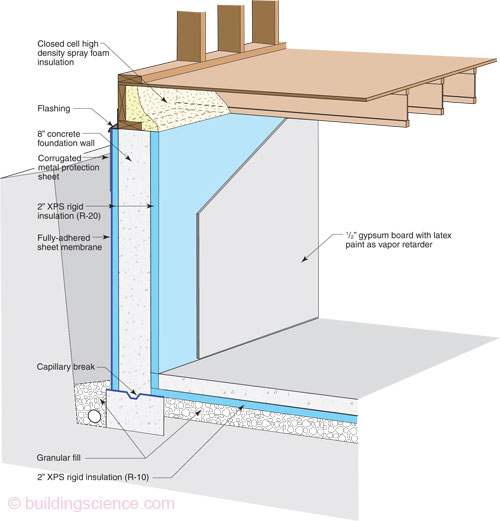This construction uses insulated concrete form (ICF) with 2" XPS rigid insulation on the interior and exterior of the concrete foundation wall. The slab is insulated with 2" XPS rigid insulation under slab and the rim joist is insulated with closed-cell spray foam insulation.

Foundation Wall
- Free draining backfill
- Corrugated metal protection sheet (to protect XPS rigid insulation above grade)
- Fully-adhered sheet membrane/dampproofing
- 2" XPS rigid insulation
- Concrete foundation wall (over a capillary break on the concrete footing)
- 2" XPS rigid insulation
- Interior gypsum wall board with vapor retarder paint
Foundation Slab
- Concrete foundation slab
- 6 mil polyethylene vapor barrier under slab
- 2" XPS rigid insulation under slab
- 4” stone pad (no fines)
- Undisturbed/ native soil
Thermal Control
This construction strategy has an installed insulation R-value of R-20 and has a predicted annual heating energy loss of 16.7 MBtus.
Moisture Control
Two inches of XPS on the interior, connected to the thermal break at the slab edge, controls the interior vapor drive and capillary wicking to the interior so there are no moisture related issues from inward vapor diffusion or capillary wicking.
Constructability and Cost
The interior of the insulated concrete form will require drywall or other thermal barrier to achieve the fire rating required by code. The gypsum board is very easy to attach to the plastic clips designed into the ICF. The drywall should not be painted, if it is not necessary, to allow maximum drying of the concrete. It may be easier and more practical to install a thin framed wall (e.g. 2x3 wood or steel framing) on the interior of the ICF to allow any necessary services to be run in the wall, and potentially more insulation.
Other Considerations
Because the concrete is installed between two vapor retarding layers, it will take several years for the concrete to dry to equilibrium. Since additional interior vapor control should be avoided, no more than latex paint should be used on the interior surface of the drywall.
Reference
Mitalas, G.P., Calculation of Basement Heat Loss, National Research Council Canada.
